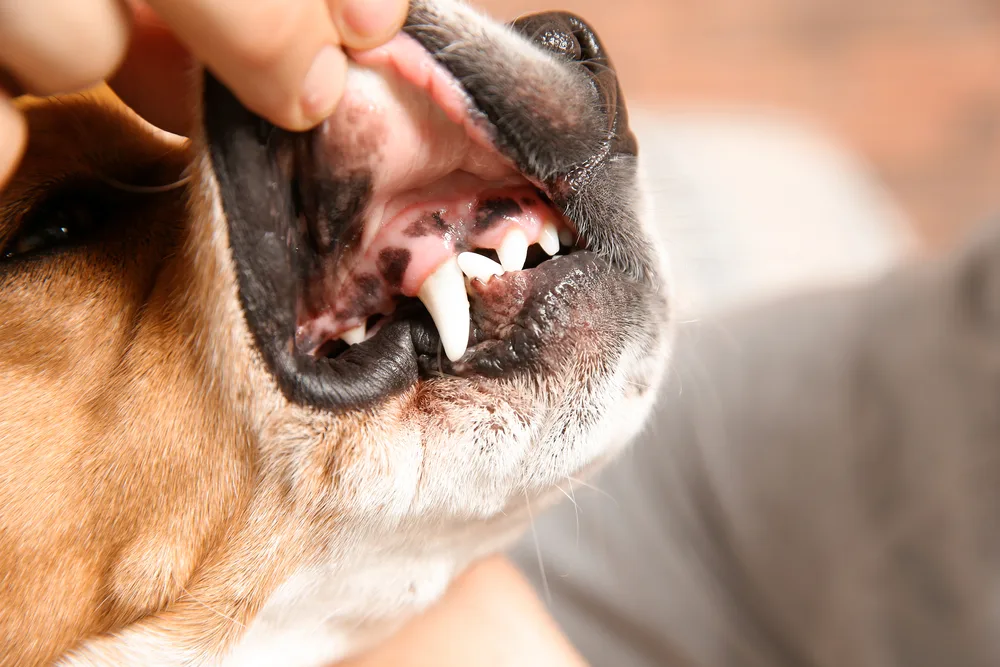Medically Reviewed by Dr. Majid Tanveer, DVM
We all like to think that our canine companions are in peak physical health. But sometimes, it can be difficult to tell just by looking.
There’s a relatively easy way to gauge your pup’s health. Just check the color of their gum tissue!
As a veterinarian and lifelong dog owner, I know how important it is to pay attention to your pup’s gum color. It can tell us a lot about their overall health and well-being.
If your dog’s gums are pink, they are likely in good health. But if their gums appear black, blue, pale, or bright red, it means that there is an underlying issue. This could signify different problems like gum disease or congestive heart failure.
Let’s go into more detail on the different gum colors and what they mean.
What Does a Normal Gum Color Look Like?

A normal gum color is bubble gum or salmon pink, even when your pup is dehydrated. This means their blood oxygen levels are normal, and they get plenty of nutrients and enough exercise.
Pink gums indicate that your pup is healthy and in good physical condition. They also have enough volume of circulating red blood cells to deliver oxygen around the body.
Pink gums also mean that your dog has a healthy immune system and is not suffering from infections or illnesses.
When checking the color of your puppy’s gums, press firmly with your index finger for a few seconds.
You will notice that the gum tissue lightens to a pale pink or white color. This is normal and indicates good blood circulation in the area.
Once you take your finger off, it should quickly return to its normal pink color. This process is known as the capillary refill time or CRT.
A healthy pup should have a CRT of two seconds or less. The gums should also be slippery and wet, not sticky or dry.
Note: Not all dogs have pink gums as the normal color. Some dog breeds may have different colors due to pigmentation.
For example, Chow Chows and Shar Peis tend to have black gums, a normal variation for those breeds.
| Gum Color | Indication |
|---|---|
| Salmon Pink | Normal and Healthy Gum |
| Pale and White | Anemia or Shock |
| Blue and Purple | Lack of Oxygen |
| Black | Normal or Oral Cancer, Gum Disease |
| Bright Red | Heatstroke, Inflammation (Gingivitis) |
| Yellow | Liver Problem (Jaundice) |
Different Gum Colors and What They Mean

It’s important to be aware of the different colors that may indicate health problems in your pup. Here are some common gum colors and what they mean:
Pale or White Gums Indicate Anemia
Pale or white gums may indicate that your pup has anemia. This is a condition where there are not enough red blood cells, which carry oxygen throughout the body.
Commonly reported signs to include lethargy, weakness, loss of appetite, rapid breathing or heart rate, increased thirst, weight loss, and yellowing of the eyes.
Several different things, such as parasites, blood loss, bone marrow failure, cancer, or nutritional deficiencies, can cause anemia in dogs. This condition can be fatal if left untreated.
Blue Gums Indicate a Lack of Oxygen
Blue gums may indicate that your pup lacks oxygen in its body tissues. This blue coloring of gum is called cyanosis.
It can signify various conditions, such as congestive heart failure, shock, or even poisoning.
Other causes of blue gum coloring may be anemia, hypovolemia (low blood volume), respiratory distress, or pulmonary edema (fluid buildup in the lungs).
Bright Red Gums Indicate Inflammation
Bright red gums may indicate that your pup has an infection or inflammation of the tissue in its mouth. This could signify periodontal disease, gingivitis, or other gum issues.
In addition to inflamed gums, your dog may experience bad breath, difficulty eating, or visible bleeding from their mouth.
Dogs suffering from heat stroke may have bright red gums due to excessive panting. This panting is their body’s way of trying to regulate its temperature.
Black Gums Indicate Potential Oral Cancer
Black gums are normal for dogs, as mentioned earlier. If you notice any raised black spots on your pup’s gums that weren’t there before, this could indicate oral cancer.
Other signs to watch for include bad breath, which may indicate periodontal disease.
If you’re not sure what’s expected or are concerned, it’s best to check in with your vet. He can help you determine if further testing is needed.
Monitor Your Dog’s Gum Color for Optimal Health
Do you know how important it is to monitor your dog’s gum color? When I had Boxer, a rescue pup, come into my clinic with pale gums, we discovered he had anemia.
Anemia can be fatal if not treated in time. Early detection of issues such as anemia can help save lives and ensure your pup’s long-term health.
Keep an eye out for any changes in hue – if the gums appear pale or bluish, head to the vet immediately. Regular exercise and nutrition are also key to keeping your puppy’s gums healthy.
So, keep a close watch on their gum color and take preventative measures – it could make all the difference!
Pet Care Tip: Check out this video on how to safely check a dog’s gums. It will show you how to check their gums without putting yourself or your dog in danger.
Readers Also Ask
What color are dogs’ gums when dehydrated?
When a dog is dehydrated, their gums will generally appear dry and dull in color. The gums may feel tacky or sticky to the touch rather than moist.
What color are dogs’ gums if they have worms?
If your dog has worms, their gums may be pale in color. You may notice signs of poor health, such as vomiting and diarrhea.
Is it okay if my dog’s gums are brown?
No, it’s not usually ok if your dog’s gums are brown. Brownish-gray gums can indicate methemoglobinemia, which is caused by the ingestion of Tylenol or other medications.
Bottom Line
Pay close attention to your pup’s gum color and health is essential.
Knowing what the different colors may indicate can help you spot health issues early on before they become more serious.
If you notice any changes in the color of your puppy’s gums, or if they seem to be in pain, contact your vet immediately. It’s always better to be safe than sorry!
